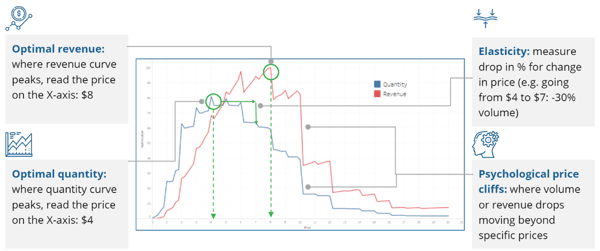Pricing of Features and Benefits: What are your Customers Willing to Pay for?
 PriceBeam
·
3 minute read
PriceBeam
·
3 minute read
-1.png?width=600&height=200&name=Email%20banners%20%20(7)-1.png)
Customer purchasing is changing, so understanding what your customers value and are willing to pay for is crucial to successfully pricing your products. The key to effective pricing is not just in balancing costs and profits but also in aligning your product’s features and benefits with customer expectations. The art and science of understanding the value of “features” vary across industries like the pricing strategy they use: Cost-plus pricing, Competitive pricing, and Value-based pricing. A crucial step in aligning your pricing with what customers are willing to pay is to understand their perceptions deeply. Value is subjective; what might be important to one segment of your customer base might be irrelevant to another. Therefore, thorough market research is essential. This research should aim to answer key questions: Which features do your customers care about? What are your customers willing to pay for?
Where to begin
It all starts with market research. Gathering insights into what your customers are willing to pay, or what features they value the most is fundamental to business growth and success. Mckinsey discovered 84% of global executives said innovation was extremely important for business growth, yet 94% were dissatisfied with their innovation performance and only 6% are satisfied with their innovation performance.
-1.png?width=600&height=200&name=Email%20banners%20%20(5)-1.png)
We see many companies add features without knowing customer value and justifying it by saying customers don't know what they want so we will choose for them – a mindset like this is set up for failure. Similar to saying “One size fits all: all features for all customers”. We’ve also seen brands say “It’s good enough”, “our brand is strong, so this will sell” and “Market research doesn’t matter, we know the market”. All these opinions will be part of the innovation failure, times have changed, and brands can no longer think in the old way as this will not lead to success. As companies innovate their products they must innovate their mindset to know who their customers are and how they purchase. Yes, in the past innovation worked as:
Design it Build it Price it Market it
But now:
Market it Price it Design it Build it
It’s up to the brands to make the change and align their strategies to the market and their customers. Market research software such as PriceBeam has enabled companies to conduct market research quicker, make more informed decisions, and go to market faster.
The Challenge
The challenge is often knowing the value customers put on single features and groups of features. The solution is market research – having data-driven insights can help optimize prices and overall increase revenue. Taking a closer look companies should utilize Choice-Based Conjoint analysis and Willingness-to-Pay. When conducting the research, companies must also consider customer segments, each with a different Willingness-to-Pay. A product might appeal to multiple customer segments, each with a different Willingness-to-Pay. Determining how to segment the market and set distinct prices for different segments without causing dissatisfaction or confusion can be challenging. This includes deciding whether to use versioning, bundling, or other forms of price discrimination to maximize revenue across segments.
The Anatomy of Conjoint Analysis
Conjoint analysis is a sophisticated technique used in market research to determine how people value different attributes (features, functions, benefits) that make up an individual product or service. The first step in conjoint analysis is identifying the key attributes of a product that are likely to influence consumer decisions. Each attribute is then divided into different levels. For example, if the product is a chocolate bar the “attributes” would be brand, type, size, etc.. and the “levels” would be the brand of chocolate bar. Respondents would select from different combinations to make choices similar to what they would do in actual purchasing situations. This could involve ranking the profiles, choosing the most preferred from a set, or rating them on a scale. The method of data collection can vary depending on the research goals and the complexity of the product. This method allows companies to simulate real-market scenarios and predict consumer behavior towards new products, features, or services, providing invaluable insights from the concept phase through to a product launch. Choice-based conjoint analysis, especially when conducted with the expertise of PriceBeam, offers a robust framework for businesses to navigate the complexities of consumer preferences and competitive landscapes.
💻Suggested Webinar ➡️Benefits of Choice-Based Conjoint Simulation
The Role of Willingness-to-pay
Willingness-to-Pay is essentially the highest price a consumer is willing to pay for a product or service. This threshold varies widely among segmentation: demographics, geography, psychographics & consumer segment. By determining WTP, companies can gauge the value attached to their products and adjust their pricing strategies accordingly. WTP research helps companies understand the value that consumers place on specific features and benefits. It reveals how much a customer values an attribute relative to other attributes, which is crucial for product development and pricing. By identifying the maximum price consumers are willing to pay for features, companies can optimize the pricing of their products based on the combination of features that offer the most value to consumers. This approach ensures that the price reflects the perceived value, which can differ significantly across different customer segments. Willingness-to-Pay research is essential for understanding how much customers value a product's features and benefits, and how this value translates into revenue.

Conclusion
Pricing based on the perceived value of features and benefits requires a deep understanding of your customers, a keen eye on the competition, and an agile approach to strategy implementation. Focusing on what your customers value most and aligning your pricing and product development with these insights can enhance customer satisfaction, increase sales, and improve profitability. Using PriceBeam’s robust frameworks will enable companies to make more informed data-driven decisions based on their target market and segment. Leveraging Choice-Based conjoint analysis enables companies to simulate real market scenarios while Willingness-to-pay highlights the maximum amount a customer is prepared to pay for a product, service, or feature. Together these will give companies the competitive edge in the marketplace.
Take PriceBeam for a spin 👇
.png?width=400&height=100&name=PBLogoTransparent%20(1).png)




